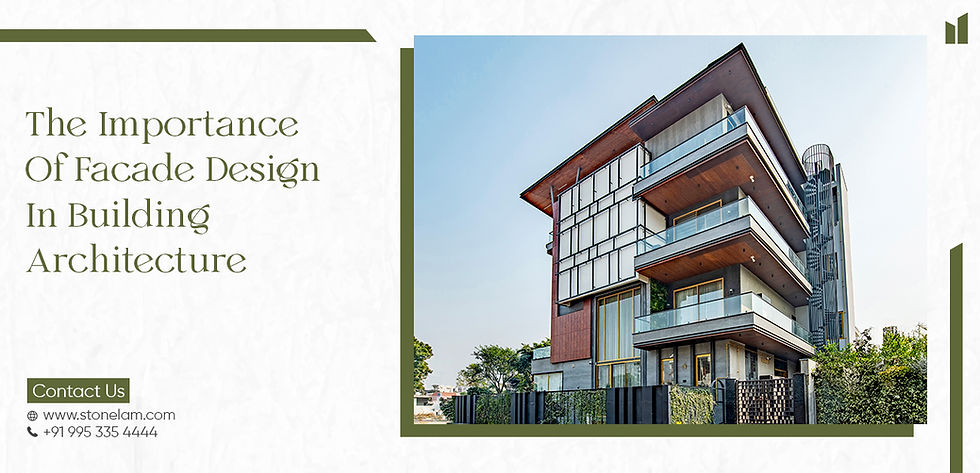Trending Facade Design Ideas in 2025
- Stonelam Seo

- Jun 19
- 3 min read

The year 2025 sees the arrival of a wave of innovative and aesthetically pleasing facade design trends, revolutionizing the way we visualize the outside look of buildings. Ranging from patterned designs to green materials, the focus revolves around creativity and functionality. This blog discusses the new design concepts of the facade, particularly tailored for modern homes and commercial buildings. We'll see trending concepts and advanced materials like porcelain slabs, providing an ideal balance of style, sustainability and strength. Whether you're a homeowner thinking of redesigning your home's facade or an architect seeking inspiration, we've got it all covered.
Dynamic and Sustainable Facade Solutions
With increasing environmental awareness, exterior façade design in 2025 embraces green materials and energy-saving solutions:
Green Facades: Adding vertical gardens or green climbing plants makes buildings come alive and enhances the air quality.
Solar Integrated Facades: Integrate solar panels quietly into building façades, providing energy efficiency while maintaining aesthetics.
Porcelain Slabs: Made up of natural material known for their strength and low maintenance, porcelain slabs are a favoured option, offering modern, sleek finishes to both commercial and residential properties.
Minimalist Yet Striking Designs
The shift towards minimalism continues, emphasizing clean lines and understated elegance in facade design for home:
Monochromatic Palettes: Simple, neutral color schemes like whites, greys, and beiges dominate, creating a sophisticated backdrop.
Geometric Patterns: Angular, bold forms and asymmetrical shapes create visual interest while remaining simple.
Large Windows And Glass Walls: Embrace the outside with maximum translucency.
High-Tech And Adaptive Facades
Technological innovation opens the doors to responsive and interactive exterior façade design:
Kinetic Facades: Panels which adapt to the action of sunlight, wind, or temperature to provide maximum comfort and energy efficiency.
Smart Glass Technology: Windows which regulate opacity to maintain privacy or manage energy.
LED-integrated panels: Add dynamic lights to emphasize architectural elements and create evening time appeal.
Regional Influences and Cultural Aesthetics
Designers are taking inspiration from the local culture and architectural motifs to develop distinctive facade design expressions:
Traditional textures with a modern touch: Melding aspects of lattice screens, carved stone and intricate tiling with modern materials.
Regional Materials: Using locally sourced materials like sandstone, terracotta, or bamboo for authenticity.
Porcelain Slabs in Cultural Hues: Select porcelain slabs that mimic the tones and textures of traditional materials while offering modern performance benefits.
Conclusion
In 2025, trends in facade design blend seamless sustainability, technology, and artistry. Designers and homeowners both are turning to new materials such as porcelain slabs, adaptive technology and dynamic lighting to transform the manner in which a building interacts with its surroundings. The mix of nature, regionality and futuristic aspects provides a diverse and lively backdrop for architectural expression. From simple home façade design to bold exterior façade design these trends give the optimal platform for contemporary architectural expression.
FAQs
1. What makes porcelain slabs a preferred choice for facade design?
Porcelain slabs offer exceptional durability, low maintenance, and resistance to weather conditions, making them ideal for both residential and commercial facade design projects.
2. How can I incorporate sustainable elements in my exterior facade design?
Use recycled materials, integrate solar panels, consider green walls, and select eco-friendly finishes like porcelain slabs to enhance sustainability.
3. Are kinetic facades practical for residential facade design for home?
Yes, kinetic facades can be adapted for residential use, providing dynamic shading and improved energy efficiency while adding a modern aesthetic.
4. Can regional architectural styles influence modern facade design?
Absolutely. Designers often blend traditional motifs with contemporary materials, including porcelain slabs, to create unique and culturally resonant facades.


Comments